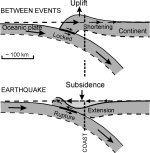lpetrich
Contributor
Your Cascadia 1700 Post is Here! by Dana Hunter
noting
Thunderbird and the Orphan Tsunami: Cascadia 1700 - Scientific American Blog Network -- Dana Hunter's Rosetta Stones -- It's the 316th anniversary of the 1700 Cascadia megathrust earthquake and tsunami!
noting
Thunderbird and Whale Overview | Pacific Northwest Seismic Network
 1700 Cascadia earthquake
1700 Cascadia earthquake
From Dana Hunter at Rosetta Stones:
The wave took about 18 hours to travel across the Pacific Ocean, and it hit Japan around midnight at the end of 1700 January 26. It smashed up a lot of buildings in several towns, but nobody got killed by it. The Japanese called it an "orphan" tsunami, one without an associated earthquake.
I note in passing that the Japanese have their own mythology about earthquakes: Namazu (Japanese mythology)
Namazu (Japanese mythology)
Several "orphan" tsunamis eventually had their "parents" identified, but the 1700 one remained a mystery until late in the 20th century. By then, plate tectonics had become well-established as a Grand Unified Theory of geological activity. The Earth's crust is divided into several plates that move relative to each other, and when one plate goes under another, it is a "subduction zone". This kind of plate boundary produces lots of big earthquakes and lots of volcanoes. Japan is on top of a subduction zone, and the Pacific Northwest is also on top of one.
So geologists started asking: where are the Pacific Northwest earthquakes? A supernatural bird and a supernatural whale fighting each other may seem like pure fantasy, but the fights' reported effects were what one would expect of earthquakes and tsunamis.
More from Dana Hunter at Rosetta Stones:
noting
Thunderbird and the Orphan Tsunami: Cascadia 1700 - Scientific American Blog Network -- Dana Hunter's Rosetta Stones -- It's the 316th anniversary of the 1700 Cascadia megathrust earthquake and tsunami!
noting
Thunderbird and Whale Overview | Pacific Northwest Seismic Network
From Dana Hunter at Rosetta Stones:
That was one version. There are several other versions of a fight between Thunderbird and Whale, with similar catastrophic effects. Some of the stories have enough details to be dated: a winter's night in the late 1600's or early 1700's.By most accounts, it was a dark and story night when Thunderbird and Whale fought their cataclysmic battle. Darkness comes early in the Pacific Northwest in January: the sun had been down for hours, and in the dark and cold, no one could see Thunderbird swoop down. But they felt it when she grabbed Whale in her talons, and rose up with it. Then she dropped Whale from a great height, slamming it into the ground. The land shook, and the waters receded. Some people knew to get into their canoes. Some didn't have time. And then came the great flood, which destroyed whole villages, and left many canoes stranded in the trees.
The wave took about 18 hours to travel across the Pacific Ocean, and it hit Japan around midnight at the end of 1700 January 26. It smashed up a lot of buildings in several towns, but nobody got killed by it. The Japanese called it an "orphan" tsunami, one without an associated earthquake.
I note in passing that the Japanese have their own mythology about earthquakes:
In Japanese mythology, the Namazu (鯰) or Ōnamazu (大鯰) is a giant catfish who causes earthquakes. He lives in the mud under the islands of Japan, and is guarded by the god Kashima who restrains the catfish with a stone. When Kashima lets his guard fall, Namazu thrashes about, causing violent earthquakes.
Several "orphan" tsunamis eventually had their "parents" identified, but the 1700 one remained a mystery until late in the 20th century. By then, plate tectonics had become well-established as a Grand Unified Theory of geological activity. The Earth's crust is divided into several plates that move relative to each other, and when one plate goes under another, it is a "subduction zone". This kind of plate boundary produces lots of big earthquakes and lots of volcanoes. Japan is on top of a subduction zone, and the Pacific Northwest is also on top of one.
So geologists started asking: where are the Pacific Northwest earthquakes? A supernatural bird and a supernatural whale fighting each other may seem like pure fantasy, but the fights' reported effects were what one would expect of earthquakes and tsunamis.
More from Dana Hunter at Rosetta Stones:
So the orphan tsunami's parent earthquake was finally identified.So, as scientists do, all the earth science folk got busy. Some of them found evidence for abrupt coastal subsidence and inundation by tsunamis along the CSZ. Others found enormous underwater landslides (turbedites) caused by huge earthquakes. Geodesists using GPS to measure the plate movements between the Juan de Fuca and North American plates found them locked. Dear, oh dear. The thing apparently liked to go big when it moved.
Further research revealed that a nice, big megathrust earthquake had made parts of the coast subside, drowning entire forests. Various clues pointed to it being at least magnitude 8.7, perhaps even as large as a 9.2. Tree rings from four different estuaries all returned dates between August of 1699 and May of 1700.

